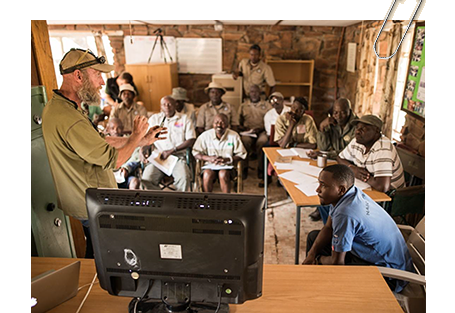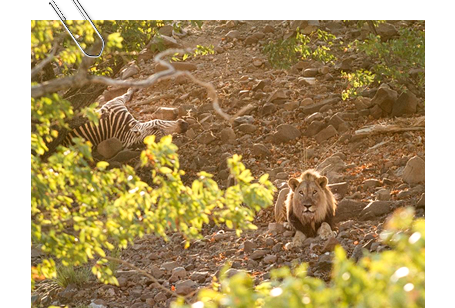Lion Ranger Training by IRDNC’s Human Wildlife Conflict (HWC) Response Unit in Kunene Region
4-11 March, 2018 at Wereldsend and Mbokondja
The week of 4 – 11 March 2018 had twelve Lion Rangers, three field coordinators, two researchers, and three IRDNC staff members gathered at Wereldsend to formally inaugurate and begin operations of the Lion Ranger Program. The programme, consisting of both the classroom ecology lesson and field practice, is spearheaded by our recently formed Human Wildlife Conflict (HWC) Response Unit in Kunene Region. The Programme enjoyed the support of the Ministry of Environment and Tourism (MET), Elephant-Human Relations Aid (EHRA) and Dr. Philip Stander of the Desert Lion Conservation Programme who provided a day-and-half workshop focusing on working desert-adapted lions in the field. Dr. Stander is spearheading his program’s monitoring of desert-adapted lions, and working to develop practical early-warning systems that our Rangers can implement.
The first days of training consisted of ‘classroom’ work (Figure 1) to brush-up on lion ecology, an overview of lion conservation across Africa, and an examination of the background and ways forward concerning human-lion conflict in the region. The Rangers themselves were invaluable contributors to all information sharing and provided a wealth of field experience drawing upon their years serving as Conservancy Game Guards.
The following days of training had the entire team up early for a field practice when a male lion began calling approximately 5-7 km northwest of Wereldsend. This was an opportune moment for the experienced Lion Rangers to showcase their tracking skills, while they learn the formal procedure on how to treat such a situation and what the appropriate ways to engage the community would be. Although the group had some disagreements on what the right procedure should be, all concurred that the Program will be stronger by having as flat a hierarchy as possible.
Further field practice was conducted in the Anabeb Conservancy where a male lion has been making his presence known very close to the Mbokondja homesteads over the past month (Figure 2) and eight cattle were recently killed near Otjiajondjira, approximately 30km north. The first task here was to inform community members about the Lion Rangers’ mandate and answer questions they have about the program. This community-engagement is critical for strengthening Ranger-community relations, so that Rangers are responsive to community concerns and represent them to the conservation community. The Rangers got to exercise working with farmers by assisting to retrieve their livestock from the bush in Otjiajondjira, and successfully practiced their tracking skills on the lion in Mbokondja.
Following this field work the Rangers had a wide-ranging discussion about the role of the Program in regional lion conservation. A central part of this discussion was how to grow the program’s information gathering capacities. This will be essential to forging a stronger role for the Rangers as the backbone for community-based lion conservation and working alongside the Namibia Ministry of Environment and Tourism to limit human-lion conflict in Kunene.
The Rangers are tasked with simultaneously addressing very real problems on-the-ground and working to forge something sustainable – a complex task! Nevertheless, continued funding and support of these committed and strong-willed Rangers will in good stead drive the lion and carnivore conservation and community development in northwest Namibia for years to come.

- Figure 1: The classroom session for the theory part of the Lion Ranger training programme.

- Figure 2: Lion citing in Mbokondja in the Anabeb Conservancy.



